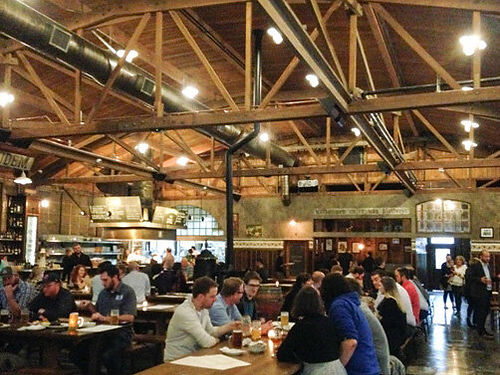

The heritage and history of the Vortox Manufacturing plant will be preserved through an adaptive-reuse of the historically-significant core buildings into a gourmet market/food hall, dubbed the Vortox Public Market.
The primary facades, outdoor loading dock, long-span trusses and interior open-space volumes, and landscaped courtyard facing Indian Hill will all be preserved and sensitively modified to adapt to current code and use. Historic interpretive displays, salvaged industrial equipment, and a community events and art space in the second floor design offices will all tell the important story of Vortox and the Garner family legacy in Claremont.
Herman Garner
Vortox Manufacturing Company founder, Herman H. Garner, was born in Maryville, Tennessee on June 16, 1886, later moving to Southern California to attend Pomona College in 1906. Following his graduation from Pomona College, Garner enrolled in the Sibley College of Engineering at Cornell University, where he earned his master’s degree in 1912. Upon returning to Southern California, Garner worked as a draftsman for the Pomona Manufacturing Company, where he helped design and build tractors.
While completing field tests on a tractor in 1916, Garner designed and developed a new type of air filter that prevented dust from entering the engine through the carburetor. By 1918, Garner had secured a patent for the “Vortox Air Cleaner” (named after the air filter’s vortex-like swirling air action) and established the Pomona Air Cleaner Company. Operating on Gordon Street in Pomona, the Pomona Air Cleaner Company manufactured air filters for agricultural equipment used in the citrus industry, later developing and producing the first oil bath air cleaner for tractor engines in 1922. The Pomona Air Cleaner Company went through a rebranding in 1924, renaming itself the Vortox Manufacturing Company after it’s popular air filter.



With the expiration of the company’s lease in the fall of 1927, Vortox moved its offices and manufacturing plant to Claremont. The move was considered to be a homecoming of sorts, as the Vortox Company and its air filter had been founded and invented by a Claremont man in Herman Garner. Beginning construction on the new office and manufacturing center in January of 1928, the complex would be situated just south of Claremont’s commercial center on a five-acre plot of land south of the Santa Fe Railroad tracks at the corner of Santa Fe Street and Alexander Avenue (now Indian Hill Boulevard).
The Vortox Manufacturing Company consistently received excellent ratings for their air filter’s dust-removing efficiency, and the company quickly established itself as a leading business enterprise in Claremont. Vortox’s premier reputation in the automotive, agricultural, and heavy machinery industries led them to receive commissions for its products from companies like International Harvester of Milwaukee, Wisconsin and saw an increase in international shipments to companies in France, England, Italy, Denmark, and Australia. The Vortox Company was a key contributor to the U.S. war efforts during World War II and the Korean Conflict, serving as a principle designer and manufacturer of oil bath air cleaners used on tanks and armored vehicles. Later in the 1950s, Vortox helped influence automotive and machinery industry standards, partnering with other industry groups to establish the basic specifications for all air filtration devices used globally in automotive, industrial, agricultural, and military applications.
With the passing of Herman Garner in 1981, management of the company was taken over by his son, Theodore H. Garner, who helped the Vortox Manufacturing Company maintain its status as a leading supplier and innovator in the air filtration field. Through product diversification, Vortox continued to adapt to meet the needs of its clients, remaining an important industrial business in Claremont well into the new millennium.

Commissioned to complete the new Vortox Manufacturing Company complex in Claremont, Arthur Munson (architect), Hayrold Glick (wrought-iron craftsman), and Clarence Stover (builder) finished the project in just three months in early 1928. Los Angeles-based architect, Arthur Munson designed several commercial and residential projects around Southern California, including Herman and Bess Garner’s home in Claremont. Likewise, Hayrold Glick also did wrought-iron work on the Garner House, before designing Vortox’s wrought-iron details and fixtures. Referred to as “the poet in wrought-iron work”, Glick kept an iron forge at the Padua Hills Theatre in the Claremont foothills for many years. Local builder, Clarence Stover, managed a prolific construction firm throughout the 1930s and 1940s, working on numerous projects in Claremont and the Pomona Valley and often partnering with notable architects like Cliff May and Millard Sheets.
Both Herman Garner and his wife, Bess acted as philanthropists and supporters of the arts and culture in Claremont. The Garners helped to construct the Padua Hills Theatre in 1930 with the Vortox Company and the theater quickly becoming inextricably linked with each other’s success. Herman Garner served as manager for both businesses, overseeing day to day operations for each. In 1933, the Vortox Company purchased a lithographic press that would be used for the printing of publicity materials for both the Vortox Company and the Padua Hills Theatre. Proving to be a useful investment, the lithographic press would provide in-house printing capabilities for both organizations for years to come. Likewise, a darkroom to develop promotional photographs for both businesses was added in the Vortox offices. World-renowned furniture designer, Sam Maloof worked as a graphic designer for the Vortox Manufacturing Company from 1934 to 1939, where he designed promotional material for both the Vortox Company and the Padua Hills Theatre. Although not an employee of Vortox, Claremont artist, Milford Zornes designed playbills, posters, and fliers for the Padua Hills Theatre while also serving as the director of the Padua Hills Art Institute for many years. Vortox’s Art Department used their lithographic press to print his work, including this beautiful drawing of the Vortox Company from 1959.

A portion of the project will be dedicated to an exhibit area – telling the history of Vortox and the Garner family to future generations to come.
















